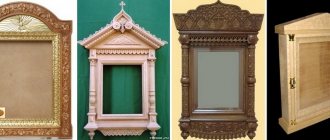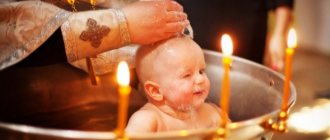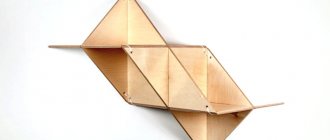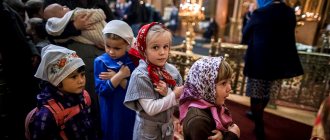Child baptism is an ancient Christian rite that has survived to this day and become a good tradition. After baptism, children receive a Guardian Angel, protection from dark forces, come to know God and are cleansed of original sin.
For Baptism you need the following attributes:
- Cross.
- Kryzhma.
- Towels.
Historically, kryzhma was a white garment worn by a Christian at the moment of leaving the baptismal font. It was a light cloth in which an adult was wrapped after the ceremony. Later, it looked like a white cape, in which adults came out of the font. It symbolized new life, cleansing from sins and the beginning of Christian life. The word “kryzhma” comes from the Polish “kryzh” - cross. Ukrainians call kryzhma “riza” from the old Ukrainian word “riza” - the ceremonial clothing of priests.
By what parameters should you choose kryzhma?
Baptism occurs only once in a lifetime and you will probably want to capture such an event in a photo. The kryzhma should look good in photographs and be combined with the overall style of the room. In order for the child to be calm and not cry, he should feel comfortable in the kryzhma. Consider these points when choosing clothes for the ceremony.
Kryzhma is selected according to the following parameters:
- Color.
- Finishing.
- Textile.
- Size.
Color
Traditionally, kryzhma should be white - a symbol of a pure soul, the divine principle. Now manufacturers make it in different shades of white: milky, cream, light beige, ivory, pearl. There are also light shades of gray, blue, purple and other colors.
Advice:
For fair-haired children, the classic white color is suitable; for dark-haired and dark-skinned children, it is better to choose cream or another shade.
Finishing
The kryzhma is decorated with the following decoration: colored ribbons, lace, beads, ruffles, fringe, embroidery, patterns, guipure, sequins, bows. The ritual attribute is often decorated with pink or yellow details for girls, and blue and light blue for boys. Do not decorate the product with hard and heavy elements to avoid injury to the child. The satin rims on the product look beautiful.
Embroidery
Most often, according to tradition, embroidery is used to decorate the kryzhma: Christian symbols, Orthodox crosses, personalized embroidery, flowers, angels, various ornaments. By embroidering the baby's name or initials, you will make the kryzhma individual.
Textile
When choosing a kryzhma, pay special attention to the material. It must have the following characteristics:
- Hygroscopicity.
Since the basis of the rite of Baptism is immersion in a font of blessed water, the fabric must be hygroscopic. The rapid absorption of moisture after dipping in holy water will make the baby’s body dry and prevent the onset of colds. - Softness.
The fabric should be soft and pleasant to the child's body. - Environmental friendliness.
We recommend choosing natural fabrics instead of synthetic ones. They do not cause allergic reactions or irritation on the body. - Antibacterial.
The bactericidal properties of fabric are important for child hygiene. A material with natural antiseptic properties can independently kill 75% of bacteria.
Focus on the season and location. For the cold season or a large cool temple, terry kryzhma is suitable, which can be fluffy or thin. For the warm season, take linen or cotton kryzhma. Voile, calico or chintz are also perfect.
Material cotton
Cotton fibers are able to absorb moisture well and regulate heat transfer. The material has antiseptic properties. The fabric is soft, light and pleasant to the body. The child will not overheat in hot weather. Often, for beauty, one layer is made of cotton, the second is made of satin. Cotton looks good with satin headbands as decoration.
Material linen
Linen is a natural soft fabric. Easily absorbs and evaporates moisture, has antibacterial properties. It has a muted shade that goes best with embroidery.
Terry material
Terry fabric is made from linen or cotton fibers; it has a fleecy and soft surface. In winter, a terry kryzhma will warm the child. Terry is hygroscopic - it absorbs moisture and removes it from the material. The baby will be comfortable throughout the Baptism ceremony.
Material calico
The fabric is summer, light and soft. Made from cotton fibers, so it has the characteristics of cotton. Quickly absorbs moisture, regulates heat exchange and kills bacteria. A type of calico - chintz - is an even lighter material.
Veil
Make sure that the veil is made of cotton or linen fibers. Refrain from purchasing synthetic veils. The veil has a luxurious, expensive look and can be decorated with embroidered patterns, designs, and borders.
Size
When choosing a kryzhma for very young children, remember the rule: it should completely cover the person being baptized.
Most common sizes:
- 75x75.
- 90x90.
- 100x100.
The small size is suitable for babies up to 3 months. It is advisable that the kryzhma have a corner or a hood, so it is more convenient to hold the child in the hands. For children over 3 months and adults, a product of universal sizes is suitable - 90x90 or 100x100.
Kryzhma - what is it
A baptismal set, including kryzhma, is often purchased by the godfather.
The baptismal set may also include
- Personalized silver spoon,
- A pectoral cross is necessary for Baptism.
- The cross is the greatest shrine of an Orthodox person, a symbol of his faith in Christ and his protection.
Choose a chain or leather cord that is long enough so that the cross can be hidden under clothing. In the Orthodox tradition, in Slavic lands, it is not customary to wear a cross on a short chain so that it is noticeable. Only Orthodox priests wear crosses over their clothes - but these are not body crosses, but pectoral (that is, “breast”, translated from Church Slavonic) crosses, which are given upon ordination to the priesthood.
It is important to remember that if you purchase a cross outside the church, you need to consecrate it by bringing it to church and asking the priest to consecrate it. It's free, or you can thank for the consecration with any amount.
All Christians wear crosses of various shapes and from various materials. Particles of the Life-giving Cross, on which Christ Himself was crucified, are today in many churches around the world. Perhaps in your city there is a piece of the Life-giving Cross of the Lord, and you can venerate this great shrine. The cross is called Life-giving - creating and giving life, that is, having great power.
It does not matter what the cross is made of, different traditions have existed in different centuries, and today a cross can be made
- Made of metal or wood;
- From threads or beads;
- Be enamel or glass;
- Most often they choose one that is comfortable to wear and durable - usually silver or gold crosses;
- You can choose blackened silver crosses - they do not bear any special signs.
The Church recommends choosing crosses with the Crucifixion - that is, the figure of Christ and the inscription “Save and Preserve,” which usually appears on the reverse side. They are sold in temples.
The Baptism gift should be appropriate and have a religious context.
- Gift editions of the book of the life of the saint or about the time in which he lived;
- The Bible is a family book that can even be passed down from generation to generation;
- A beautiful lamp for the “red corner” - the home iconostasis of the house;
- Chain for a pectoral cross;
- Ring “Save and preserve” with a cross and prayer;
- Chain for a pectoral cross (for a child - “for growth”);
- Bracelets with a prayer or with a cross (now on sale there are men's, women's, and children's - one-size-fits-all);
- The most traditional option is a beautiful, hand-painted or self-embroidered icon of the patron saint;
- Vessel for holy water;
- Audio and video CDs with spiritual content.
What should you do with kryzhma after baptism?
Many people believe in the magical properties of kryzhma, so they keep it all their lives as a respectful relic, without further use. Kryzhma is a personal amulet and is not inherited. There is a belief that by preserving it, a person maintains his happiness. Some people put kryzhma in the crib if the child is sick, believing in a faster recovery due to its healing properties. This item cannot be washed, as drops of myrrh may remain on it. It is also not worth storing it among everyday clothes. A separate cover will prevent the appearance of stains and foreign odors. The cotton cover will additionally protect the roof from dust and ensure air circulation.
Others say that the most important thing is the rite of Baptism itself, and all the attributes accompanying it serve only as a reminder. Kryzhma is just a piece of fabric, and all beliefs have no basis. It is necessary to carefully select godparents who are responsible for ensuring that the child grows up as a believer. Which opinion you join is up to you to choose.
How to choose kryzhma for a child’s baptism
The variety of kryzhmas in our store is great, so it is important to decide on the following:
- the baptism kit will include a towel or diaper;
- age of the child - take into account the size of the rim, the presence of a hood;
- design - for a boy, a girl or universal.
For older children over 3 years old, it is more appropriate to buy a large towel to dry a standing child, or a special sheet so that he can wrap himself in it. Infants up to one year old are received by godparents in winter in a towel with a corner hood or an insulated kryzhma so that the baby does not catch a cold, and in summer - in a thin lace diaper.
When choosing, keep in mind that when storing the baptismal set, the diaper will not take up much space, unlike a bulky terry towel.
Christening caps, towels and diapers for boys and girls differ in the color of the embroidery. For boys, blue, blue, green, and gray colors are mainly used. Embroidery for girls is done in pink, peach, lilac and sometimes even blue in the color of the Mother of God. Milky, beige, gold and silver are universal for any gender, and white is simply a classic in embroidery on christening supplies.
Who brings?
The responsibility to bring kryzhma to church lies with the godmother. She is the one who has to buy it or sew it. An unbaptized child is brought to the temple, a ceremony is performed and he is immersed in the holy font, from where he is taken out already baptized. Before placing the child in the kryzhma, the priest will consecrate it. It is the godmother who receives the godson from the font, wrapping him in cloth. The child will remain in the kryzhma until the end of the traditional baptism process. Then the baby is dressed in clothes, and the parents take the sacred fabric with them to carefully store.
Why choose our baptismal caps
We ourselves are a manufacturer of clothing and textile accessories for Epiphany, so the prices for kryzhmas and other products are affordable, and the quality is high! All products presented in the catalog are certified and approved for use by children from birth.
Here you will find models of roofs from modest and discreet to solemnly elegant. The price directly depends on the material of the product, as well as the presence of lace and other decorative elements. Rectangular towels with a factory edge are cheaper than square models with satin trim and lace trim.
You can buy your favorite kryzhma for a boy’s Baptism on the website or through a call back. When delivering by courier in Moscow, you can choose from several models. We invite you to see the entire range “live” in our showroom in Moscow. Delivery to the regions is carried out by Russian Post.
After the christening
What to do with kryzhma after baptism?
According to popular beliefs, it is a talisman for a child throughout his life. Therefore, parents need to preserve it. There is a widespread belief that kryzhma can help a baby during illness. The mother needs to take it out and wrap the child when he feels unwell so that relief comes. Also, parents sometimes find the use of kryzhma as a towel for the child’s face, covering him with it while he sleeps. Since ancient times, there has been an opinion that if a person keeps his kryzhma all his life, he will be happy. Therefore, some believe that this fabric should simply be protected, not used in everyday life, and especially not washed. Therefore, after bathing, it is better to dry the child with a regular towel, and put the kryzhma in a secluded place, but not among everyday clothes or linen. To protect it from stains, odors, dust and damage, it is recommended to purchase or sew a special cover made of cotton fabric. In any case, whether the lid will be used or not, it is advisable to take care that it is not lost or damaged.
What material should I choose for my christening towel?
One of the most common options for towels after baptism are terry towel options. They can be made from:
- Cotton,
- bamboo,
- Flax,
- Synthetic terry.
Often modern manufacturers offer satin materials for christening towels. Of course, this material looks luxurious, but it is unlikely that a child will be comfortable in it. It is quite possible that the child will simply freeze in such material.
Size and material
The size of the kryzhma depends on the age of the child.
If this is a baby under three months old, you can choose an option with a length of 75 cm on all sides. For older children, they buy fabric measuring one meter by one meter. It is very convenient to use a model with a hood on one of the corners. This kind of kryzhma for the baptism of a child is most suitable for the youngest. It is important to consider the time of year for which the christening is scheduled. In winter or autumn, of course, it is better to give preference to a terry towel, fluffy or not. In any case, the material should be soft, pleasant to children's skin, and have the ability to absorb moisture well. Terry suits these requirements best. Linen, calico and cotton fabrics are also often used. Satin and silk look very impressive and beautiful, but they cannot absorb moisture so well. They can be used provided that the baptismal cover consists of two layers. The top one can be made of noble material, and the bottom one can be made of cotton or terry.
What it is?
The baptismal cap is a simple piece of fabric, a new diaper, towel or even clothes, preferably white. It is known that it symbolizes the purity and sinlessness of man. This is exactly what a child is like when he first visits an Orthodox church after his birth. Now it is possible to buy ready-made kryzhma, made from high-quality natural materials and with appropriate symbols, or you can sew it yourself or order it from a studio. The main symbol of Orthodoxy is the cross, therefore it is desirable that it be present on the kryzhma. This will become a distinctive element that will indicate the spirituality of this piece of fabric or garment.
For many parents, it is very important that everything is not only correct, but also beautiful. Photo and video recording of the sacrament of baptism is now not prohibited, so everyone strives to preserve treasured footage in order to show them to the child in the future. After all, baptism is a holiday that happens only once in a lifetime. But the choice is not only related to visual aesthetics; in fact, the baptismal kryzhma is of great importance.
For girls and boys
If desired, the material is simply hemmed or the headbands are made of satin. If you are going to baptize a girl, give preference to pink or yellow. All sorts of bows, flowers, and ruffles will serve as decorative elements. The kryzhma for a boy’s baptism can be made of soft blue fabric or decorated with elements of this shade. It is also not forbidden to use pale green, blue or lilac colors. From such fabric it is necessary to make geometric inserts or decorate the kryzhma with ribbons. Hemstitching and embroidery also look very original and unusual. The most skilled craftswomen can try to depict angels, doves, and decorate the kryzhma with a personal inscription.











